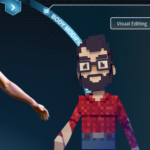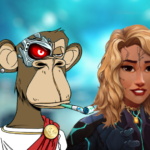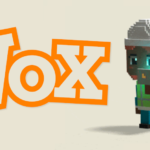When we talk about the metaverse as a unified digital environment, we also need to think about the way we represent ourselves through our avatar. CryptoAvatars allows you to create a completely unique 3D avatar that you own as an NFT, and that represent you across the metaverse. Before we dive into the technical bit, first some background information on why this is relevant.
Header credits go to Vianvolaeus. Follow on Twitter.
To some extend our crypto wallets are already a data-driven representation of who we are inside the metaverse. Our wallets reveal how deep our pockets are, but also which DeFi dapps you’ve used, what type of games you like, and where you buy your NFT art. Wallets are like a gateway into someone’s soul, to some extend.
Web domains like .crypto by Unstoppable Domains are a way to have your wallet represented by something similar to an user name. But those domains are ‘just’ a nickname, and we’d also need to connect that nickname to a visual representation. That’s where projects like CryptoAvatars and Genies come into play. These projects allow you to create a visual representation of yourself, which could be exactly like you or something completely different.
A visual representation doesn’t need to look like you. In the NFT space we already see people using for example Avastars as their representation. Especially, WhaleShark has taken this to a next level, using his most valuable Avastars character as visual layer during live interviews. These avatars make you recognizable as a particular person in the metaverse, on the internet, without revealing who you are in real life. Change identity? Then switch wallet, and thus you switch avatar, and therefore your identity will change.
Now, let’s talk about CryptoAvatars…
CryptoAvatars is a curated platform where creative designer can publish their avatars, making them ready for use across different applications including VR Chat, Webaverse and Somnium Space. Let’s learn how to add our 3D character creations to the CryptoAvatars platform.
Technical requirements for a CryptoAvatars character
When done making an avatar, make make sure that the final product matches some requirements. In order for avatars to be used in VR Chat, there’s a limit of 7,500 triangles. Make sure you have rigged the avatar after a humanoid (two arms, two legs, body and head) and preferably compatible with Mixamo, 3D computer graphics technology software. This software is free for anybody with an Adobe license. You will need to use blendshapes to add facial animations to your avatars. And ultimately the VRM file needs to be 25MB max.
First create an FBX file
- First make a 3D character in Blender. Make sure it has arms, legs, a body and a head. There are plenty of tutorials on character creation on YouTube. Like this one. Take some time to learn this though! It will be worth it. For now I assume you have already made something awesome!
- When exporting from Blender, make sure you include the rig, the mesh and the blendshapes.
- Keep in mind that there’s a maximum of 7,500 triangles.
- Go to File > Export Selection > Export as FBX (make sure Animation and Deformed Models have been selected, select Centimeters in Units, and use the FBX File Format: FBX 2013)
Import FBX into Unity
- Make sure you have Unity installed. Create a new project using Unity version 2019.3.9f1.
- Download the VRM software development kit from VRM.dev. Make sure you get the Unity package! Once you’re done downloading, you can drag-and-drop it into Unity. Once installation has been completed, there’ll be a VRM folder and the VRM menu option will appear in the tool menu on top.
- Make a new folder inside Unity, and drag-and-drop your FBX avatar into it. Also import the texture files, make sure these are in ‘normal map’ mode.
- Then right-click create > Material > and drag-and-drop the textures into the Main Maps ‘Albedo’ field.
- Now you’re ready to make your avatar move. Click on the Mesh file, then select Rig, and from the drop-down select Humanoid as you Animation Type. Apply, Save Scene, and now let’s configure your Rig more.
- Here it’s important that your characters ligaments correspond with the correct label. The left upper leg needs to be recognized as the left upper leg. In case of doubt, click Pose and then Force T-Pose.
- When done. Go to the Scene Menu > select Mesh > go to VRM menu option on top > select UniVRM from the drop-down, and select Export Humanoid.
- Fill in your info, select Force T-Pose, select Pose Freeze, select Use Experimental Export. Then Export to the same folder as where you other avatar files are. New folders will appear in your project area.
- Now delete the Mesh from the Scene Menu, and drop the Pre-fab in the Scene instead. It immediately has a T-Pose.
- Now again, select the Mesh > VRM > UniVRM > Export Humanoid. Now you can make sure Force T-Pose, Pose Freeze and Use Experimental Export have been unselected. Then Export.
- Now you have exported a VRM file. Keep in mind that this avatar isn’t fully compatible yet with VR Chat. There are additional steps to arrange that, and CryptoAvatars will provide documentation on how to arrange this.
Connecting with CryptoAvatars
Once your done with the design of your avatar, let’s apply for our entry into the metaverse:
- Apply here using the pre-application form. Before the team would accept a designer into the program, it’s important to have at least one example of an avatar working.
- Polygonal Mind, the developers behind CryptoAvatars, use a separate channel for designers on Discord. So make sure you join their Discord for easy communication.
- If you’re not familiar with minting an NFT or avatar onto the blockchain, they will provide you with a step-by-step guide. This includes a Blockchain information guide, a Metamask guide, a guide for creating an account and upload your avatar to the platform, an Avatar Technical Guide and internal documentation of Polygonal Mind related with avatars.
- Designers are invited to share sketches and 3d models of their avatars with Polygonal Mind. They will ensure that all avatars match the technical requirements for an open standard of metaverse avatars.
- Once the design has been finished, Polygonal Mind will verify whether the avatar works in VR environments.
- When the design has been completely approved, the designer needs to provide a name, description, tags for their selfmade avatar as well as a 1030x1440px image containing his avatar. Taking into account that the thumbnail will cut the borders.
- When he mints the avatar, the creator can keep, transfer or send it.
- Since CryptoAvatars has now whitelisted the artist, they are eligible to create more avatars and upload them to the platform.
- On Cryptoavatars.io you can login using your Metamask wallet. Click Create New Avatar. Your avatar will get a custom standard frame from CryptoAvatars. In addition you need to provide a name, description, and a maximum of 10 tags. The VRM file should be less than 25 MB.
Closing words
There’s quite some work into creating an avatar for the metaverse, but that avatar represents YOU. It’s not a game character that you play for some hours, but it’s your very own representation across a wide variety of virtual worlds. Having your own avatar in the metaverse is well worth it, and following this guide and teaming up with CryptoAvatars, will make sure your creation is following an open-standard for avatar creation. These avatars are compatible with virtual worlds, some chat programs, some games and (hopefully) the future.
[ays_quiz id=’5′]




